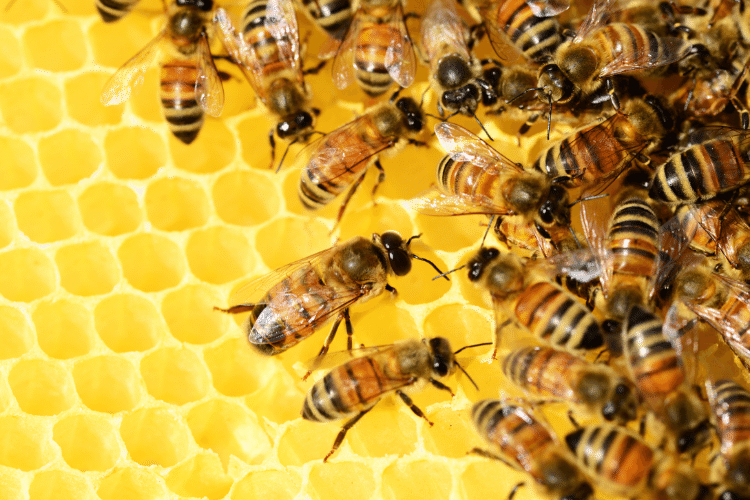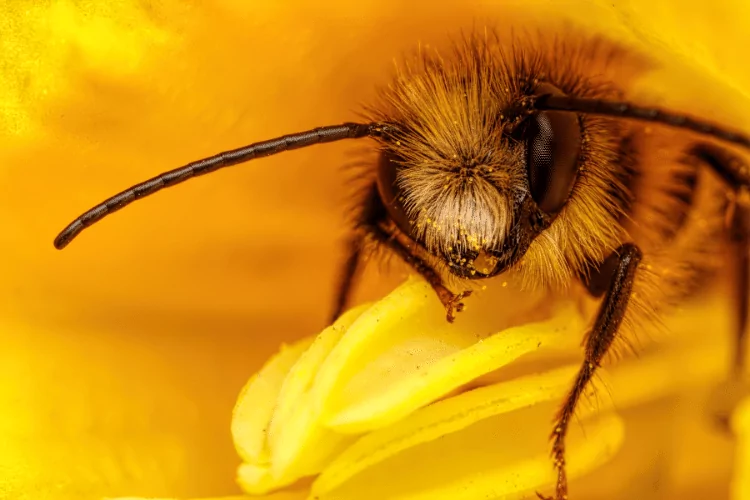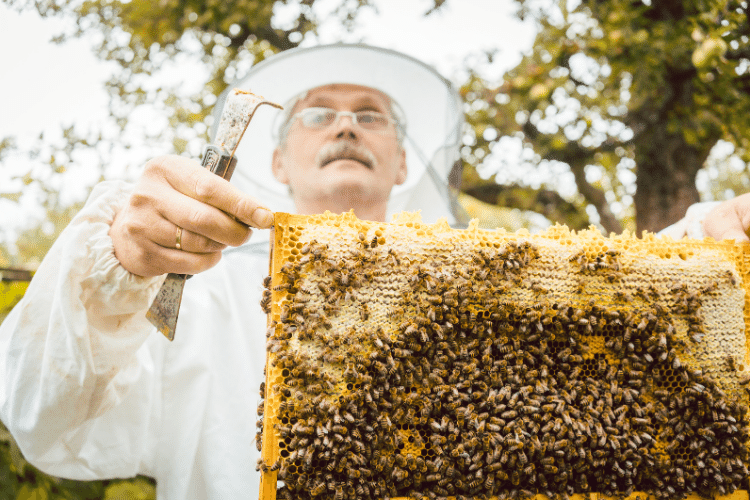Bees are one of the world’s most valuable insects for many reasons. Not only do they produce honey, but they’re also incredibly efficient pollinators.
Without them, most of the flowers on Earth would disappear in a matter of months. Because of that, these little critters are exceptionally important for our ecosystem.
There are many types of bees in the world. Some of them are faster flyers, while others are better at picking up pollen.
Although they all look similar. For that reason, it can be a little difficult to identify the different types.
So, if you want to learn more about the distinctions between Mason Bees vs. Honey Bees, you’ve come to the right place.
In this article, we’ll walk you through the characteristics of both species. We’ll also cover the major variations and similarities between the two.
Mason Bees Overview
Mason Bees are a species of insects in the Megachilidae family. These little critters are gentle and usually don’t mind being around humans.
They get their name from how they construct their nests. These bees will gather masonry products, like mud or clay, to create their homes.
Plus, they prefer to hide away in little caverns. The bees will find naturally occurring gaps in stones or wood and build a nice nook for themselves.
Moving on, Mason Bees like warm weather. That’s why you’re more likely to see them starting from spring all the way to late summer.
Honey Bees Overview
Most of us are familiar with this variety of bees. These critters are the ones responsible for the production of honey.
They’re members of the Apidae family and have a docile demeanor. Honey Bees are gentle and have a low tendency to swarm.
That’s why many beekeepers are able to raise them in large colonies.
Other than that, these bees are flexible on where they nest. They can build homes underground or in open areas.
Mason Bees vs. Honey Bees
Now that you have some background information on the bees, we can jump into the differences. In this section, we’ll cover some of the most notable features of the critters.

We’ll also discuss their major similarities and distinctions.
1. Appearance
Bees are tiny little creatures that can fly at incredible speeds. This makes it tough to distinguish any of their physical features.
Because of that, most people think that bees all look the same. Although, if you take a closer look, you’ll notice that the two species have distinct appearances.
Starting off, Mason Bees have furry bodies. They have hair-like structures that help them pick up pollen.
Plus, these insects come in a variety of shades. The most common colors are metallic blue or green.
Although some Mason Bees have black bodies, and even rust-red. On top of that, their stripes typically match the shade of their exoskeleton.
Besides that, male Mason Bees have longer antennae and a tuft of light-colored hair on their heads.
Moving on, Honey Bees look a little different. Right off the bat, you’ll notice that they have less fur.
There are sections of their bodies with no hair at all. Other than that, Honey Bees have bulky bodies with yellow or brown stripes.
However, the two species also have a few physical features in common. For example, both have segmented bodies.
In addition, Mason Bees and Honey Bees have stingers.
2. Size
On average, an adult Mason Bee can grow up to about ¼ to ¾ of an inch in size. Plus, females are usually a bit larger than the males.
Honey Bees, on the other hand, can reach ¾ of an inch. As you can tell, Mason Bees are slightly smaller than Honey Bees.
Yet, this difference is barely noticeable in the real world.
3. Anatomy
There are a few anatomical differences between Honey Bees and Mason Bees. One of the most noticeable is the distinction in jaw formation.
Honey Bees have two movable jaws that we call mandibles. Instead of up and down, these structures can move in and out of the insect’s mouth.
This helps them support their long tongues to make collecting nectar easier.
Moving on, Mason Bees have large, scissor-like jaws. These structures are powerful and extraordinarily sharp.
They’ll allow the bees to gather mud, pulp, and leaves to construct their nests.
4. Life Cycle
The life cycle of a bee starts out in a cocoon. With both species, the males are typically the first to emerge.
Although, that’s where the similarities end.
Male Mason Bees will emerge, then wait around for the females to hatch. After that, each female will mate with one or more males and fly off.
Sadly, the males will die soon after mating. This allows the females to set off on their own and establish nests.

Honey Bees have a much more complex hierarchy. For starters, the males can only mate with the queen of the colony.
All the other females will take on the role of caring for the hive. They’ll keep it clean and tend to any unhatched brood.
5. Lifespan
On average, Honey Bees can live anywhere between 30 to 60 days. This will depend on the environment and the state of the hive.
Plus, the availability of food and shelter will also come into play.
As for Mason Bees, they lead shorter lives. Commonly, they’ll survive for just under a month in the proper conditions.
That’s most likely because Honey Bees form massive colonies. The large number of insects working together will make finding resources much easier.
6. Behavior
Mason Bees and Honey Bees don’t behave in the same way. Each species has a unique social structure.
For starters, Honey Bees build their colonies around a queen. This is a special female bee with fully developed ovaries.
Because of that, this flying critter is the only one capable of making more baby bees. We call the other female bees in the colony worker bees.
These act as protectors and the gatherers for the hive. Every member of the colony will work together to create a safe environment.
Moving on, Mason Bees aren’t as social as Honey Bees. In fact, these critters are solitary creatures.
Since all females are fertile, they don’t need a queen. Instead, each female will go out on their own and build a new nest.
7. Relationship With Other Animals
Both Honey and Mason Bees are surprisingly friendly creatures. They rarely sting unless provoked.
Because of that, they generally get along with other animals. Yet, Honey Bees run into more altercations than Mason Bees.
That’s not due to them being aggressive, rather it’s a protective instinct. Since these bees produce honey, they attract many predators.
For instance, skunks, raccoons, opossums, and bears all love the sweet treat.
8. Nests

You can learn a lot about bees by examining their nests. Each species approaches building a home from a different angle.
As we mentioned, Honey Bees like to live in large colonies. For that reason, they prefer to dig their own nest holes.
They’ll find a location that can withstand a massive population with room for expansion. Other than that, Honey Bees construct their homes out of wax.
Moving on, Mason Bees are a little lazier. Since they don’t need large spaces, they prefer using pre-existing holes.
They’ll look for abandoned animal hiding places or cracks in rocks. That way, they don’t have to build the nest from scratch.
Plus, Mason Bees will use any materials around them to create the home. That includes dead leaves, mud, and sometimes even wood shavings.
Finally, Honey Bees are much better at nest thermoregulation. They gather in one spot, around the queen, to warm up their home in the winter.
9. Sting
We talked about how both bee species have stingers. However, Honey Bee stings can do a lot more damage.
That’s because their stingers are hollow and pointed. Plus, they have two rows of lancets (saw-tooth blades).
For that reason, Honey Bee stings usually hurt a great deal.
As for Mason Bees, they have solid stingers, but they’re smooth on the outside. This results in a sting that’s closer to a mosquito bite than a Honey Bee sting.
10. Pollination
Both Honey and Mason Bees are able to pollinate all sorts of flowers. Yet, they do so with different efficiency levels.
Since Mason Bees have furrier bodies, they can carry more pollen at a single time. This means they’re much more effective at pollination.
To make this a little clearer, here’s an example.
It’ll take about six or seven Mason Bees to fully pollinate a fruit tree. Yet, the same tree will need a few hundred Honey Bees for the same effect.
Wrapping Up
To find out the differences between Mason Bees vs. Honey Bees, there are a few factors to consider.
For starters, there are major distinctions in appearance, anatomy, and life cycle. Other than that, you’ll notice a little contrast in behavior, lifespan, and nesting habits.
Yet, these two bee species also have a couple of features in common. For instance, they’re both gentle and have segmented bodies.
- Does Bleach Kill Bees? - April 23, 2024
- How Do I Get Rid of Ants Without Harming Bees? - April 16, 2024
- Do Bug Zappers Kill Bees? Completely Explained - April 9, 2024
